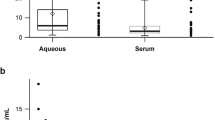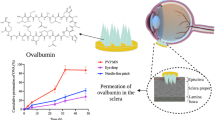Abstract
A theoretical model is presented that is able to explain for the first time the pressure drop across the trabecular meshwork. The ramified flow paths in the subendothelial region of the trabecular meshwork can be interpretated as a filter bed. Data from transmission electron microscope (TEM) photographs are the starting point of the theoretical consideration. Taking shrinkage of the sections into account, the pressure gradient across the subendothelial region amounts to 0.05 mm Hg. As these canaliculi are coated by a film of glycosaminoglycans (GAGs), the pressure drop is presumably a function of the film thickness. Only film thicknesses of 0.35 μm lead to pressure gradients in the experimentally verified magnitude. As the whole filter bed probably does not contribute to the filtration but only about 10%, the pressure drop specified is reached when the GAG coating is 0.25 μm. As these values seem to be fairly realistic, it can be concluded that the subendothelial region of the juxtacanalicular meshwork (about 2 μm thickness) can be regarded as the “locus generis” of aqueous humor outflow resistance.
Similar content being viewed by others
References
Bill A (1977) Basic physiology of the drainage of aqueous humor. In: Bito L, Davson H, Fenstermacher J (eds) The ocular and cerebrospinal fluids. Exp Eye Res [Suppl] 25: 219
Bill A, Svedbergh B (1972) Scanning electron microscopic studies of the trabecular meshwork and the canal of Schlemm. An attempt to localize the main resistance to outflow of aqueous humor in man. Acta Ophthalmol 50: 295
Bohl W (1980) Technische Strömungslehre. Vogel Verlag, Würzburg, p 123
Erikson A, Svedbergh B (1980) Transcellular aqueous humor outflow: a theoretical and experimental study. Graefe's Arch Clin Exp Ophthalmol 212: 187
Grant M (1958) Further studies of facility through the trabecular meshwork. Arch Ophthalmol 60: 523
Kamm R, Palaszweski B, Johnson M, Richardson T (1983) Calculations of flow resistance in the juxatacanalicular meshwork. Invest Ophthalmol Vis Sci 24: 135
Lütjen-Drecoll E (1973) Structural factors influencing outflow facility and its changeability under drugs. Invest Ophthalmol 12: 280
McEwen W (1958) Application of Poiseuille's law to aqueous outflow. Arch Ophthalmol 60: 290
Moseley H, Grierson J, Lee W (1983) Mathematical modelling of aqueous humor outflow from the eye through the pores in the lining endothelium of Schlemm' canal. Clin Phys Physiol Meas 4: 47
Richardson T (1982) Distribution of GAGs in the aqueous outflow system of the cat. Invest Ophthalmol Vis Sci 22: 319
Segawa K (1975) Ultrastructural changes of the trabecular tissue in primary open angle glaucoma. Jpn J Ophthalmol 19: 317
Seiler T, Wollensak J (1984) Über den Abflußwiderstand im Trabekelwerk. Sitzungsberichte der Berliner Augenärztlichen Gesellschaft 1982. Klin Monatsbl Augenheilk 184: 581
Author information
Authors and Affiliations
Rights and permissions
About this article
Cite this article
Seiler, T., Wollensak, J. The resistance of the trabecular meshwork to aqueous humor outflow. Graefe's Arch Clin Exp Ophthalmol 223, 88–91 (1985). https://doi.org/10.1007/BF02150951
Received:
Issue Date:
DOI: https://doi.org/10.1007/BF02150951




